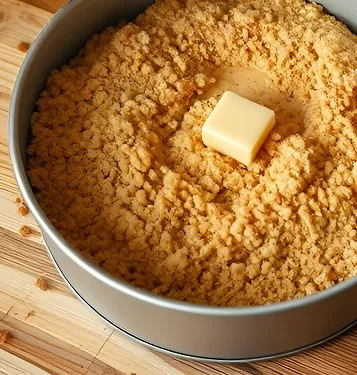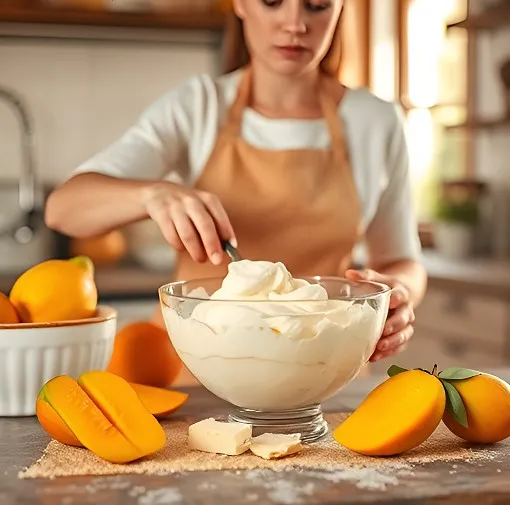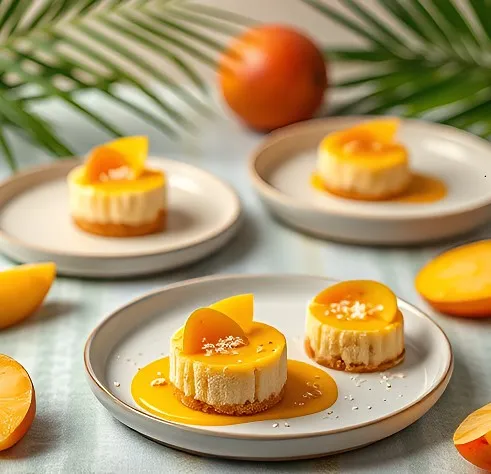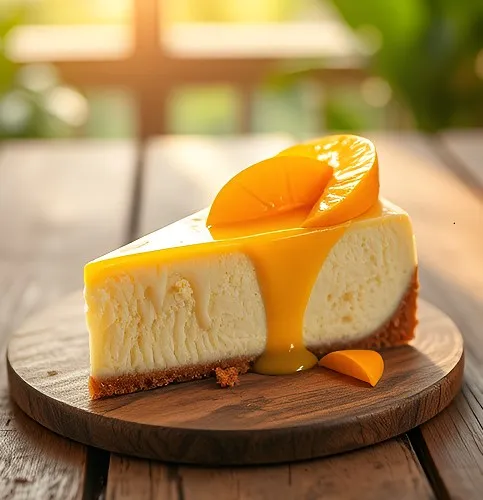A Tropical Decadence: Embracing the Mango Cheesecake Fantasy
There’s nothing quite like the vivid taste of summer captured in a dessert, and few treats do that better than a perfectly crafted mango cheesecake. This delightful fusion marries the tropical zing of fresh mangoes with the creamy richness of traditional cheesecake. Whether you’re a seasoned baker or someone who simply loves a good dessert experiment, mango cheesecake offers a transportive experience for the senses—a feast that not only excites your palate but also elevates any gathering into a vibrant celebration.
Table of Contents
The Unmatched Appeal of Mango Cheesecake
Mango cheesecake isn’t just an ordinary dessert; it stands apart because of its remarkable duality. On one hand, you get the lush, tropical flavor of mangoes—a fruit celebrated around the world for its versatility and natural sweetness. On the other, you enjoy the classic decadence of cheesecake, a dessert appreciated for its creamy texture and indulgent nature. Together, they create a dish that bridges the gap between a light, fruity dessert and a rich, satisfying treat.
What makes this dessert a true crowd-pleaser is its adaptability. Its bright appearance and balanced taste make it a fitting centerpiece for nearly any occasion—from an intimate brunch with friends to a glamorous dinner party. When served, the vibrant hue of mango blended with the pale tones of cheesecake sets a festive mood, promising that what’s coming next is equally exciting on the palate. It’s the kind of dessert that sparks conversation even before anyone takes their first bite.
Moreover, mango cheesecake’s appeal lies in its texture. The crisp, buttery base contrasts with the airy, smooth filling, while bursts of mango (whether integrated as a puree or sprinkled as tender chunks) add a refreshing twist. Each bite unfolds layers of flavor; the tanginess of the fruit balancing the velvety sweetness of the cream cheese while keeping the overall experience light and summer-perfect. In essence, every slice is a complex yet harmonious mix of flavors, textures, and aromas, making mango cheesecake a versatile dessert that’s sure to win hearts at any table.
Exploring the Spectrum of Mango Cheesecake Styles
The versatility of mango cheesecake means there is a style for every baker. Depending on your mood, dietary preference, or simply the occasion at hand, you can tailor your approach to this dessert masterpiece.
For those who appreciate the traditional, the baked mango cheesecake stands out. This time-honored method involves slowly combining ingredients, baking to a perfectly set consistency, and allowing a gradual cooling process that ensures each bite is as smooth as the one before. The baked version typically features a dense, rich filling coupled with a sturdy base—ideal if you’re searching for a dessert that feels like an indulgent treat after a hearty meal.
Alternatively, if you’re pressed for time or prefer a lighter dessert during those sweltering days, the no-bake version offers a fantastic alternative. No-bake mango cheesecakes often rely on setting agents like gelatin or agar-agar to achieve that signature firmness without the need for an oven. This method is not only quicker but results in a texture that is refreshingly less dense and more airy, making it particularly appealing when you crave something that’s cool and invigorating.
Many modern recipes even incorporate creative techniques such as swirling mango puree throughout the cheesecake filling. This technique not only intensifies the tropical flavor in every bite but also creates an artful presentation with natural gradients of color. Whether you opt for a uniform mango flavor or experiment with a marbled effect, the possibilities are endless and let you put your own signature twist on the recipe.
In essence, each variant of mango cheesecake—from the robust baked creation to the delicate no-bake style—carries its own charm. Your choice ultimately depends on your personal taste, the occasion, and how much time you’re able to commit to the process. Whichever style you choose, you’re guaranteed a slice of tropical heaven on your plate.
Building the Perfect Mango Cheesecake: Key Ingredients and Their Role
A great mango cheesecake is a symphony of flavors that hinges on the careful selection of its core components. Each ingredient plays an indispensable role in balancing the vibrant fruit notes with the creamy, tangy allure of cheesecake.
Let’s begin with the foundation: the crust. This base is more than just a supporting element; it sets the stage for the entire dessert. Many bakers prefer a crumbly crust made from graham crackers, whose slight sweetness and crunch make it an ideal complement. Others lean towards digestive biscuits for a subtler, less sweet alternative. Even cookie-based crusts have gained popularity, offering unique textures and flavors that turn the humble base into a memorable highlight. Whether you choose to craft the crust from scratch or opt for a convenient, pre-made version, it’s crucial to ensure that this layer is stable enough to support the luscious filling above.

At the heart of the dessert is the cream cheese. This is where the magic of cheesecake originates. For the smoothest filling, it is essential to use softened cream cheese. Allowing it to come to room temperature—usually one or two hours before use—ensures a lump-free, velvety mixture. Most traditional recipes suggest full-fat cream cheese, which provides that undeniably rich and creamy texture. However, if you’re looking to reduce the calorie load, low-fat alternatives are available, though they might slightly alter the indulgent mouthfeel.
Complementing these essential components are the mangoes themselves, the star of the show. When selecting mangoes, look for fruits that are slightly soft to the touch and emit a ripe, sweet fragrance. Fresh mangoes usually offer the best flavor, but high-quality frozen mangoes or even a well-made mango puree can work in a pinch. Each option has its merits: fresh mangoes bring a burst of natural juice and texture, while puree ensures a uniform distribution of flavor throughout the filling. Be mindful, however, of the added sugar content in some pre-made purees or canned versions, as this can tip the delicate balance of sweetness.
No cheesecake would be complete without the humble ingredients that bring it all together: sugar, eggs, vanilla extract, and a hint of lemon juice. Sugar doesn’t merely sweeten the concoction; it also works to create a smooth texture when blended with the cream cheese. Eggs act as a binding agent, ensuring that the filling sets perfectly. A splash of vanilla extract infuses a warm, aromatic note, while a squeeze of lemon juice provides a subtle contrast that cuts through the richness of the cream. It is this purposeful interplay between ingredients that transforms a simple dessert into a culinary experience.
Every element in your mango cheesecake, from the carefully chosen crust to the luscious filling and the carefully balanced flavor accents, plays a critical role. As you begin your dessert journey, remember that attention to detail at this stage is key. Patience and quality in your ingredient choices are the first steps towards creating a dessert that captivates both the eyes and the taste buds.
Mastering the Art: A Step-by-Step Mango Cheesecake Recipe
Now that we’ve explored the components, it’s time to roll up your sleeves and dive into the actual process of making your mango cheesecake. This methodical approach breaks down each stage of the recipe, ensuring that even if you’re new to cheesecake-making, you can confidently achieve a dessert that’s both breathtaking and delicious.
To begin, preheat your oven to the temperature specified in your recipe—usually around 320°F (160°C). While the oven warms up, start by creating the crust. In a mixing bowl, combine your choice of graham cracker crumbs, digestive biscuit pieces, or crushed cookies with melted butter and a modest sprinkle of sugar. Stir thoroughly until the crumbs are evenly moistened. Once the mixture achieves a consistency similar to wet sand, press it firmly into the base of your springform pan. An even layer is essential; use the flat back of a spoon or the bottom of a glass to create a compact, uniform crust. Some recipes recommend pre-baking this layer for 8–10 minutes to help prevent sogginess later on. This pre-baking step is particularly beneficial if you’re planning a cheesecake with a rich, creamy filling.
Next comes the filling, where all that careful ingredient selection comes into play. Transfer softened cream cheese into a large mixing bowl. Beat it with granulated sugar until the mixture is smooth and velvety, with no discernible lumps. Take your time with this step—the smoother the cream, the more luxurious your cheesecake will be. Once the sugar is well incorporated, add eggs one at a time, beating gently after each addition. This gradual incorporation helps maintain the batter’s smooth texture and prevents overmixing, which could lead to an undesirable dense consistency.
Now, it’s time to introduce your tropical twist—the mango. Depending on your preference and availability, add either freshly pureed mango or tender chunks of the fruit. Gently fold the mango into the cream cheese mixture, ensuring even distribution without overmixing. If you’re inspired to create a visual piece as well as a culinary one, reserve a few tablespoons of mango puree to later create a swirl effect on the top of your cheesecake. A gentle fold is key here; you want the fruity accents dispersed throughout while still preserving pockets of the mango’s natural vibrancy.
With your filling prepared, gently pour it over the pre-baked crust, smoothing the top with a spatula. For an extra-touch of finesse and to help avoid unwanted cracks, consider baking your cheesecake in a water bath. Place the filled pan inside a larger roasting pan and fill the outer pan with hot water up to about halfway up the side of your cheesecake pan. This method creates a moist, even baking environment that prevents the top from drying out and forming unsightly cracks.
Transfer the water-bathed cheesecake into the oven and bake it slowly. Keep a close eye on it throughout the process—most recipes require a baking time of about 50 to 70 minutes, though this can vary depending on the precise recipe and the temperature of your oven. The cheesecake is done when the edges are mostly set while the center maintains a gentle, slight wobble. Resist the temptation to over-bake; a slight jiggle is perfectly acceptable and will vanish as the dessert sets.
After removing the cheesecake from the oven, allow it to cool gradually. A useful tip is to let it rest in the oven with the door ajar for about 30 minutes before transferring it to the countertop. This gradual cooling minimizes sudden temperature changes that could lead to cracks in the finished product. Once it reaches room temperature, cover the cheesecake with plastic wrap and place it in the refrigerator. For ideal consistency, let it chill for no less than four hours—overnight for an even firmer set is even better.
This step-by-step method ensures that each component of your mango cheesecake is prepared with care and precision. By following these detailed instructions, you’ll be well on your way to producing a dessert that not only tastes divine but also demonstrates the artful balance of tropical flavors and classic cheesecake creaminess.
Innovative Twists: Creative Variations for the Adventurous Baker
For those whose creative spirit extends beyond the confines of a traditional recipe, there are plenty of inventive ways to put your own spin on the mango cheesecake. Experimenting with variations not only keeps the dessert-making journey exciting but also lets you tailor the flavors and textures to your personal taste.
One popular variation is the no-bake version of mango cheesecake. Ideal for warm days when you want to skip the oven’s heat, these recipes use setting agents such as gelatin or agar-agar to create the firm texture you’d expect from a traditional cheesecake. The process is much simpler and faster, and while the texture might be slightly lighter than its baked counterpart, it remains every bit as refreshing. In a no-bake dessert, maintaining the authenticity of the mango flavor is paramount—fresh or frozen mangoes, blended into a smooth puree, are the perfect addition.
Another exciting twist is the creation of a mango swirl cheesecake. Instead of mixing all of the mango puree into the batter at once, try layering dollops of mango puree over the top and using a knife or skewer to gently swirl the contrasts together. This technique doesn’t just enhance the visual appeal with marbled patterns—it also creates pockets of intense mango flavor in every slice, offering a delightful surprise as you enjoy your dessert.
For party settings or individual servings, making mini mango cheesecakes is a fun and creative option. Using a muffin tin or small ramekins, you can transform the recipe into bite-sized portions that are perfect for social gatherings or portion-controlled treats. These individual desserts not only enhance the dining experience but also allow your guests to sample the dessert without the need for slicing a large, traditional cheesecake.
Toppings offer yet another dimension of customization. Consider finishing your creation with a topping of fresh mango slices that provide a burst of color and a pleasant textural contrast. Alternatively, a light drizzle of mango coulis—a smooth sauce made from mango puree and just a hint of sugar—can elevate the dessert further by intensifying the fruit’s natural flavor. For those who appreciate a little extra indulgence, a dollop of freshly whipped cream or a sprinkle of toasted coconut can be the perfect finishing touch, adding a subtle crunch or a creamy contrast that complements the dessert’s overall profile.
The beauty of the mango cheesecake lies in its flexibility. Whether you stick to a tried-and-true recipe or boldly experiment with creative variations, each twist and turn in the process is an opportunity to make the dessert uniquely yours. Embrace these innovations, let inspiration guide you, and remember that every variation is a step toward mastering a dessert that’s as versatile as it is delicious.
Troubleshooting: Overcoming Common Mango Cheesecake Challenges
Even the most experienced bakers encounter a few bumps along the road when preparing a delicate dessert like mango cheesecake. Understanding common challenges—and knowing how to address them—ensures that your end result is as flawless as it is delectable.

A frequent issue is the appearance of cracks on the cheesecake’s surface. These can occur when the cake experiences a rapid change in temperature. To preempt such problems, always allow your cheesecake to cool gradually. The water bath technique not only promotes even baking but also minimizes the risk of surface cracks. Once the cheesecake is done, resist the urge to take it out too quickly; instead, let it rest in a moderately warm environment before the slow transition to cold storage.
Texture is another area that can prove challenging. Overmixing the batter, for example, may incorporate too much air, causing the cheesecake to set with an undesirably dense texture. Aim for a gentle mix—just enough to combine the ingredients—so that the filling remains luxuriously smooth without becoming tough. Conversely, underbaking can leave the center too soft or runny, undermining the structure needed for clean slices. The key is to look for a center that still gives a subtle “wobble” at the end of the baking cycle but will firm up as it cools.
A soggy crust is also a point of concern for many bakers. This issue is often resolved by pre-baking the crust before adding the filling, which helps to create a firmer base that resists absorbing excess moisture from the creamy topping. Finally, flavor balance is critical. If the cheesecake seems too tangy or too sweet, adjust the ratios of lemon juice and sugar in your batter. Tasting the mixture before baking can guide you in fine-tuning these elements so that the final product reflects the perfect harmony of flavors you envisioned.
With these troubleshooting tips in mind, you’re better equipped to handle any unforeseen challenges that may arise. Confidence and careful attention to detail will ultimately yield a mango cheesecake that is as visually stunning as it is tastefully flawless.
Serving, Storing, and Savoring Your Mango Cheesecake
After dedicating time and passion to creating your mango cheesecake, the final step is to serve and enjoy your masterpiece. Presentation matters—a slice of mango cheesecake can be enhanced by pairing it with complementary beverages that accentuate its tropical aroma. A chilled glass of white wine or a sparkling tropical juice can transform your dessert into a gourmet experience.

While the cheesecake is best served well-chilled for that firm, refreshing texture, leaving it out for a few minutes at room temperature before serving can soften it slightly, making it easier to cut and enhancing the flavor release. For storing, cover any leftovers well in an airtight container and keep them refrigerated to preserve freshness. If you find yourself needing to store the dessert for a prolonged period, wrapping it carefully before freezing—and then thawing it in the refrigerator overnight—will help maintain its delightful texture and flavor.
Frequently Asked Questions
A few common questions often arise when tackling a mango cheesecake recipe. For instance, many wonder whether canned mango can be used. While it’s certainly possible, fresh or high-quality frozen mangoes typically yield better flavor and texture. Another frequent query concerns how to know when your cheesecake is fully baked: the edges should be firmly set, and the center should still exhibit a slight wobble without being runny, indicating that it will firm up as it cools.

